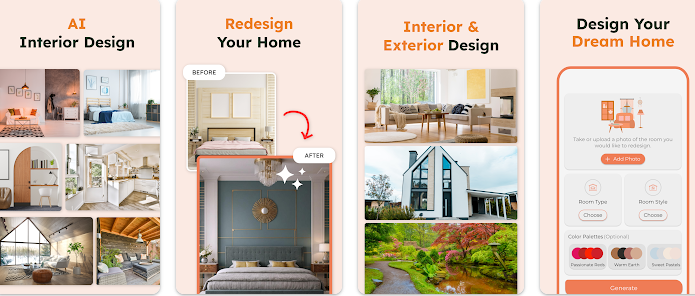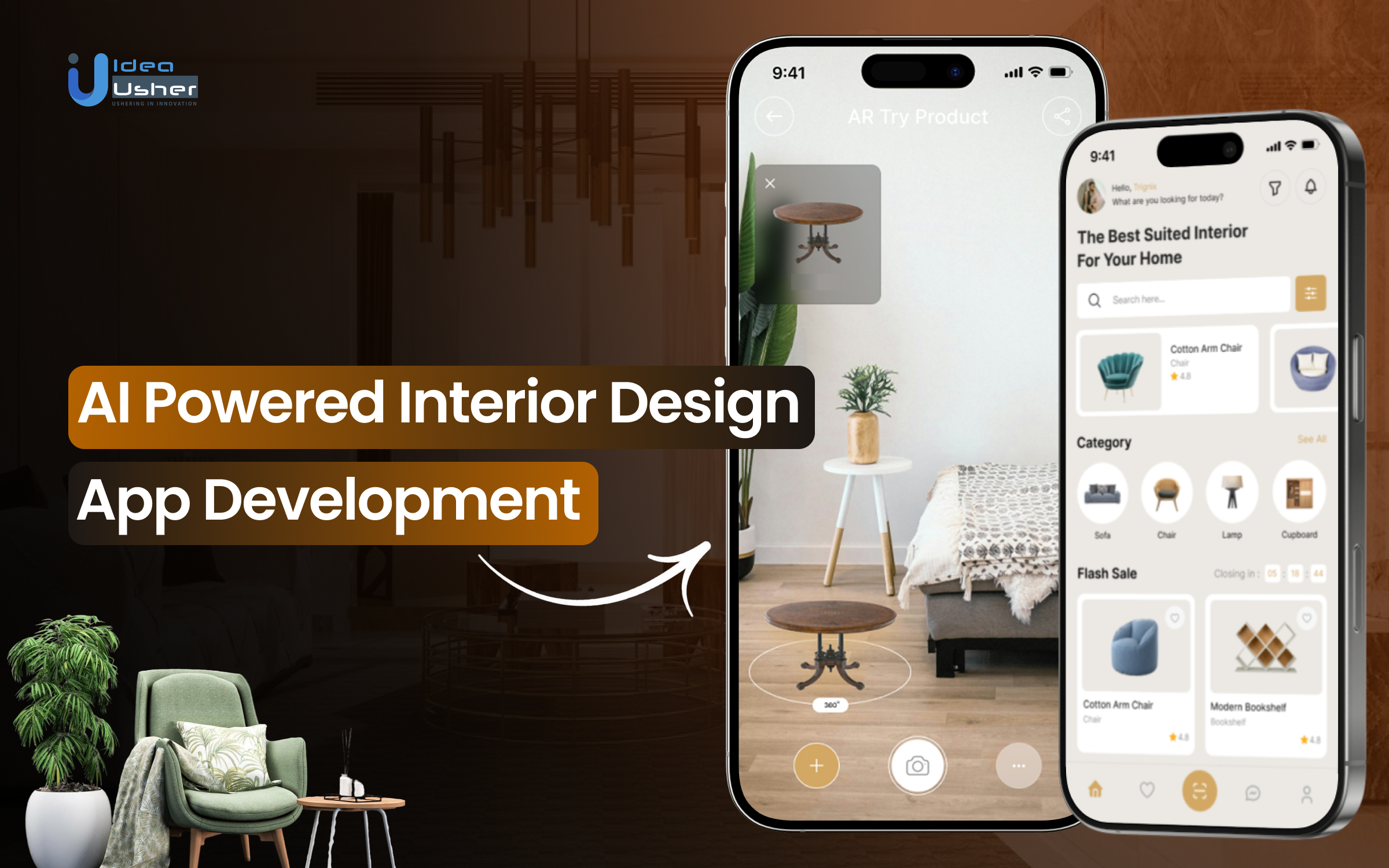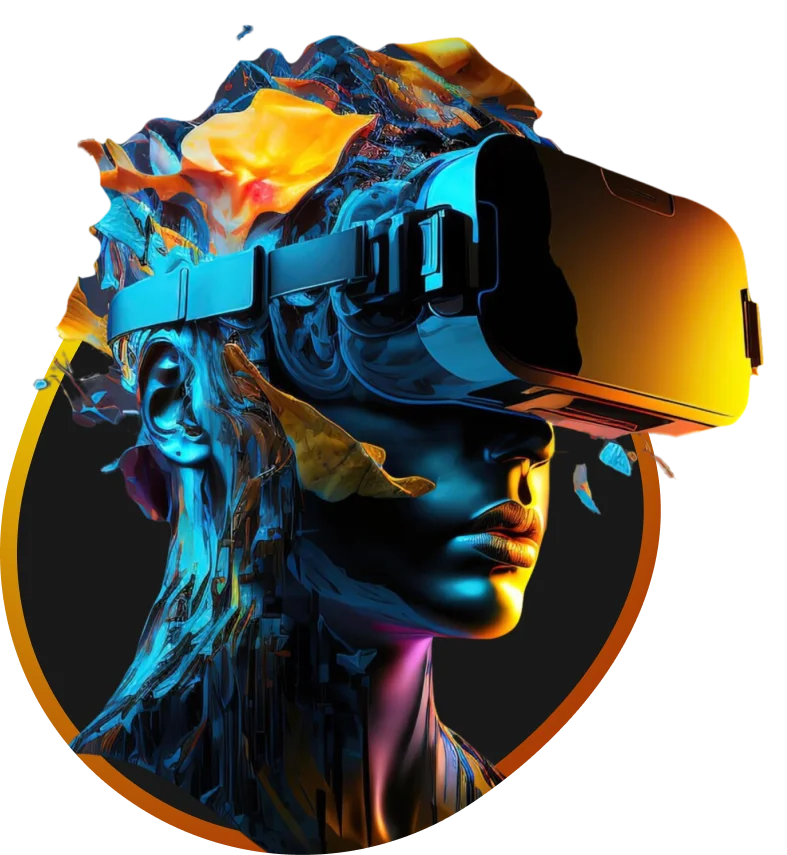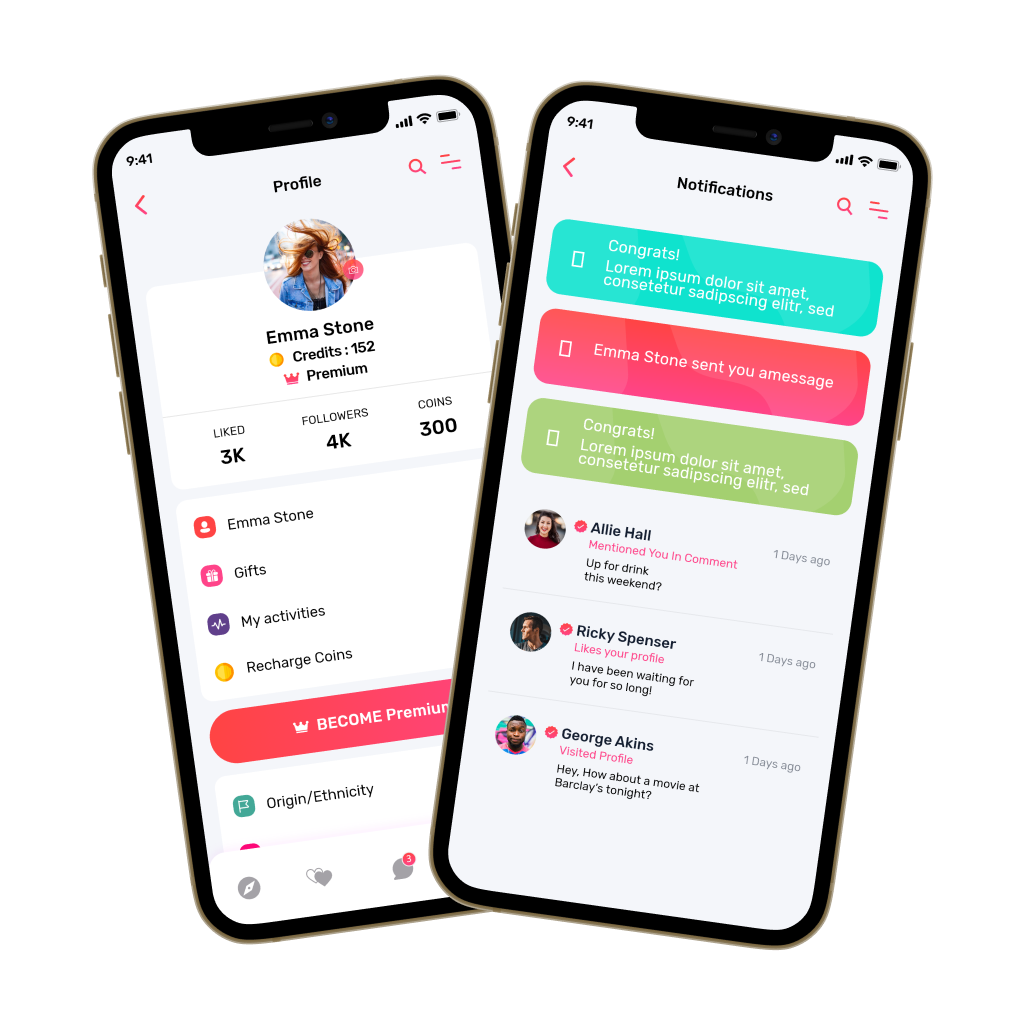Imagine walking into a home that reflects your unique style and personality. AI is making that dream a reality by transforming the way we design interiors. With user-friendly AI-powered apps, individuals can effortlessly input their preferences, room sizes, and desired aesthetics to receive tailored design suggestions. By harnessing advanced technologies like machine learning and computer vision, these innovative tools allow anyone to create beautiful and functional spaces that truly feel like home.
These apps are not only popular but also demonstrate the lucrative potential of AI in interior design.
In this blog, we’ll walk you through the key steps and technologies involved in building an AI-powered interior design app. Let’s start!
Key Market Takeaways for AI Interior Design Apps
Source: GlobalMarketEstimates
This rapid growth is fueled by the increasing demand for personalized designs, advancements in AI technology, and the integration of AR/VR in interior design, making it easier for people to bring their dream spaces to life.
AI interior design apps are becoming a go-to solution for homeowners, DIY enthusiasts, and professionals alike. These apps use machine learning and deep learning to analyze user preferences, room sizes, and design trends to offer personalized recommendations. For instance, apps like Decor8.ai allow users to easily plan home makeovers. At the same time, Interior AI can transform a simple photo of a room into a realistic rendering based on the user’s style choice.
Partnerships and innovations are also shaping the future of AI interior design. A prime example is Wayfair’s introduction of Decorify in July 2023. This generative AI-powered tool lets users upload photos of their rooms and instantly view photorealistic transformations in different decor styles.
Work with Ex-MAANG developers to build next-gen apps schedule your consultation now
Why This is the Perfect Time to Invest in an AI Interior Design App?
Launching an AI-powered interior design app is a great opportunity, with more people looking for personalized, tech-driven design solutions. Whether for DIY homeowners or professional designers, this app can provide tailored suggestions based on preferences, budget, and space.
For example, Roomstyler 3D Home Planner lets users create 3D room models and experiment with layouts. It has over 10 million users and makes money from in-app purchases and premium features.
Designhill, another AI-driven platform, raised $10 million in 2021 and offers personalized design services, showing strong growth potential in the market.
AI interior design apps can also become highly profitable through different revenue streams. They use subscription models and one-time purchases. They also earn from in-app features and partnerships with furniture brands.
As technology evolves these apps can add even more advanced features. They keep users engaged and bring in new ones.
Key Features of an AI Interior Design App
An AI interior design app brings the best of technology to home design, offering personalized solutions and efficient tools. Here are the standout features:
1. AI-Powered Design Suggestions
The app uses machine learning to understand what users prefer. It then offers customized design ideas. RoomGPT is a great example. Here users can upload their room photos and get tailored design suggestions based on their preferred style.
2. Augmented Reality Room Visualization
People can use the AR feature to place different pieces of furniture in their living spaces. This helps them visualize how each item will look in their room before making a purchase. IKEA’s app offers this feature, and many customers love it because it allows them to experiment with various styles and furniture options, ensuring they choose the best fit for their space.
3. 3D Modeling and Virtual Staging
Users can convert 2D floor plans into 3D models for a detailed view of their space. With tools like Planner 5D, users can upload their room photos and instantly see them transformed into a 3D design to visualize furniture arrangements and decor.
4. Automated Space Planning
AI helps users make the most of their space by suggesting furniture placements that optimize both the layout and aesthetics. Apps like Remodeled.ai use algorithms to generate personalized room layouts based on room size, ensuring the space is utilized efficiently.
5. E-Commerce Integration
Users can design their space and shop for items without leaving the app. Spacely AI identifies furniture and decor within the design and links users directly to online stores to purchase similar pieces, making the design process smooth and seamless.
6. Intelligent Color Palette Selection
Users can choose the perfect color scheme with AI-powered suggestions. Apps like Palazzo.ai analyze room size, lighting, and preferences to recommend colors that match design goals, making color selection easy and intuitive.
Development Steps for an AI Powered Interior Design App
Here are the steps to develop an AI interior design app,
Step 1: Market Research & Niche Identification
Before diving into development, you need a solid understanding of the market:
- Identify your target audience (homeowners, interior designers, real estate firms, etc.)
- Conduct a competitor analysis (study popular apps like Houzz, Planner 5D, DecorMatters)
- Define your unique selling proposition — What makes your app stand out?
Pro Tip: Look for gaps in existing apps. For example, is AR accuracy lacking? Or do the AI suggestions take too long? These are areas where you could improve.
Step 2: Define Core Features & AI Capabilities
The core of your app includes AI-based style recommendations, AR/VR room visualization for 3D furniture placement, automated floor plan generation from sketches, and smart product sourcing that suggests furniture based on style preferences. These features combine to offer a personalized design experience.
Advanced AI Features:
- Neural style transfer: Apply famous art styles to room designs (like Picasso or Van Gogh-inspired living rooms!)
- Voice-guided design assistant: For example, “Make this room more modern” or “Give this room a cozy vibe.”
Step 3: Choose the Right Tech Stack
The tech stack is essential for your app’s performance and scalability. Here’s what to consider:
- AI/ML Models: TensorFlow, PyTorch, OpenAI CLIP
- AR/VR Integration: ARKit (iOS), ARCore (Android), Unity 3D
- Backend Development: Node.js, Python (Django/Flask)
- Database: Firebase, PostgreSQL, MongoDB
- Frontend (Mobile): Swift (iOS), Kotlin (Android), React Native (Cross-platform)
- Cloud Services: AWS, Google Cloud, Azure (for AI processing)
The right mix of technologies will ensure a seamless experience for your users, regardless of the device they’re using.
Step 4: Data Collection & AI Training
AI thrives on data, so make sure you collect high-quality data sets to train your algorithms:
- Interior design databases: Pinterest, Houzz, ArchDaily, etc.
- 3D furniture models: Collaborate with brands like IKEA or Wayfair for a wide variety of furniture items
- User-generated room scans: Allow users to upload their room scans (ensuring compliance with privacy regulations)
Training Your AI Models:
- Use image recognition models to identify furniture, colors, and design styles
- Implement generative AI to create new design layouts based on user input
- Use recommendation algorithms to suggest products based on trending designs and user preferences
Step 5: Prototype & UI/UX Design
The UX should be smooth and intuitive, with a drag-and-drop interface for easy design, realistic 3D previews to visualize ideas in real life, and a personalized dashboard where users can save designs, favorite products, and receive tailored recommendations.
Tools to Use:
- Figma / Adobe XD for wireframing and prototyping
- Blender / SketchUp for 3D modeling and realistic visualizations
Creating a smooth, intuitive interface is key to keeping your users engaged.
Step 6: Develop MVP
Before launching fully, start with an MVP to test key features like AI design suggestions, basic AR room scanning, and e-commerce integration (if monetizing through affiliate sales). This allows you to gather feedback and refine your app before a broader release.
Benefits of an MVP:
- Faster time to market
- Easier to get early user feedback
- Lower development costs in the beginning
An MVP helps you test ideas and make adjustments before fully committing to the project.
Step 7: Rigorous Testing
Testing is super important to make sure your app runs smoothly and accurately. Make sure your AI gives relevant, personalized design suggestions, that the AR places furniture correctly in real rooms, and that the app performs well without slowdowns or crashes. It’s all about giving users a seamless experience!
Testing Methods:
- A/B testing different recommendation styles
- Beta testing with real users to gather feedback on the interface and functionality
The more thorough your testing, the better the final product will be!
Step 8: Launch & Marketing Strategy
Now that your app is ready, it’s time to share it with the world! Try collaborating with influencers in the interior design space, create AI-generated demo videos to highlight your app’s unique features, and offer a freemium model with free basic features and premium upgrades. It’s all about generating excitement and getting people on board!
Post-launch Growth:
- Use AI to create personalized ads targeted to users based on their design preference.
- Partner with furniture brands to drive in-app purchases and increase revenue
A strong marketing plan ensures that your app reaches the right audience and gains traction.
Step 9: Continuous AI Optimization & Scaling
Collect user feedback to refine AI suggestions, regularly update with new design styles and trends to keep things fresh, and explore new markets like real estate staging or hotel design for even more growth opportunities. Stay ahead by continuously evolving!
Cost of Developing an AI Powered Interior Design App
Here’s a detailed breakdown of the costs involved in developing an AI-powered interior design app.
| Cost Component | Description | Estimated Cost Range ($) |
| Research and Planning | Market analysis, feasibility studies, defining scope & features | 1,000 – 5,000 |
| UI/UX Design | Creating an intuitive and visually appealing interface | 2,000 – 10,000 |
| Front-End Development | Building the user-facing part of the app | 3,000 – 20,000 |
| Back-End Development | Server-side logic, database management, API development | 4,000 – 25,000 |
| AI Implementation | AI functionalities, image recognition, 3D modeling, algorithms | 5,000 – 40,000 |
| – Basic AI suggestions | Simple AI-driven recommendations | 5,000 – 15,000 |
| – Advanced AI visualization | 3D modeling, AR-based room visualization | 20,000 – 40,000 |
| App Features | Functional elements that impact cost | |
| – Basic room layout tools | Simple room design tools | 1,000 – 3,000 |
| – 3D modeling & AR | Advanced 3D modeling and augmented reality integration | 5,000 – 15,000 |
| – Furniture & decor integration | Integration of furniture catalogs and decor elements | 2,000 – 8,000 |
| Testing & Quality Assurance | Ensuring stability and reliability | 2,000 – 10,000 |
| Deployment & Maintenance | App store deployment, updates, and ongoing maintenance | 1,000 – 5,000 |
Factors Affecting the Development Cost of an AI Powered Interior Design App
Building an AI-powered interior design app involves extra costs beyond standard app development. While typical expenses cover UI/UX, platform, and team expertise, the AI component adds complexity. Here are the main factors:
- AI Model Complexity and Accuracy: Advanced AI features, like 3D rendering and style recommendations, require sophisticated algorithms and larger datasets. The more accurate and detailed your AI needs to be, the higher the cost.
- Dataset Acquisition and Management: AI needs large datasets of room images and furniture models. Gathering and curating high-quality data can be pricey, but it’s crucial for a good user experience.
- 3D Modeling and Rendering Quality: Realistic 3D visuals require skilled 3D artists and powerful rendering tools. More detailed renderings mean higher costs for processing power and cloud computing.
- Integration with Furniture and Decor Databases: Connecting with online furniture retailers or managing a product database adds costs for API development, data syncing, and ongoing maintenance.
Challenges and Solutions in AI Interior Design App Development
Here’s a breakdown of the common challenges faced during AI interior design app development, along with practical solutions,
1. Challenge: High-Quality 3D Rendering Requires Powerful GPUs
Realistic 3D rendering, especially in augmented reality, demands a lot of computing power. For users on mobile devices, this can cause lag, overheating, or a subpar experience.
Solutions:
- Cloud-Based Rendering – Offload the heavy computational tasks to cloud servers (like AWS, Google Cloud, or Microsoft Azure). This way, the user’s device only needs to stream the results, reducing the strain on mobile hardware.
- Optimized 3D Models – Compress and simplify 3D assets to maintain visual quality while reducing the load on the device. This ensures that rendering is smooth without sacrificing detail.
- Progressive Loading – Instead of loading everything at once, break down textures and models into smaller parts that load gradually as needed, ensuring smoother transitions and faster load times.
Pro Tip: For ultra-high-quality rendering, consider partnering with powerful tools like NVIDIA Omniverse or Unreal Engine. These platforms offer GPU-accelerated rendering, delivering stunning visuals even with complex environments.
2. Challenge: Data Privacy Concerns with User Room Scans
When users upload room photos or floor plans, there’s always a risk of personal data being exposed or misused. Privacy concerns are especially important, as non-compliance with regulations like GDPR (EU) or CCPA (California) could lead to serious legal issues.
Solutions:
- End-to-End Encryption – Encrypt user uploads with strong algorithms like AES-256 to ensure all data remains secure. This means data is protected both when it’s uploaded and while it’s being processed.
- On-Device Processing – Keep the data processing on the user’s device to ensure that room scans and photos don’t leave their personal space. This reduces security risks while providing a faster, more private experience.
Pro Tip: For added security, consider blockchain-based storage, which allows for decentralized, tamper-proof data handling. This ensures that sensitive data is more secure and reduces the risk of breaches.
3. Challenge: AI Training Requires Massive, Diverse Datasets
To offer highly personalized recommendations, AI models require vast and varied datasets, including different room layouts, furniture styles, and color schemes. Collecting this data can be time-consuming and costly, especially when building a diverse database from scratch.
Solutions
- Partnerships with Furniture Brands – Collaborate with furniture retailers like IKEA, Wayfair, or West Elm to integrate their product catalogs into the app. This provides real, high-quality data while giving users access to an expansive range of furniture choices.
- Synthetic Data Generation – Use technologies like NVIDIA GANs (Generative Adversarial Networks) to create artificial yet realistic training images. This method reduces the need for real-world data while offering diverse, AI-friendly images.
Pro Tip: To reduce the need for large datasets, use transfer learning by fine-tuning pre-trained models like CLIP or DALL·E. This helps the AI adapt to specific tasks or domains with less data, making the training process faster and more efficient.
Most Successful Business Models for AI Interior Design Apps
Here are the most successful business models for AI powered interior design apps,
1. Subscription-Based Model
This business model involves users paying a recurring fee (monthly or annually) to access premium features and services, ensuring a steady income stream for the app developers. Subscription models work well because they provide continuous updates, customer retention, and predictable revenue.
Example: Interior AI offers a Pro Plan for $39/month, which includes premium features like advanced rendering, virtual staging, and Sketch2Image.
2. Credit or Pay-Per-Use Model
In this model, users buy credits or pay for each design or render they generate, making it ideal for users who need specific, occasional designs rather than a full suite of tools. This model is great for casual users or professionals who don’t require a subscription.
Example: REimagine Home offers a credit-based system where users can purchase credits (e.g., $14/month for 30 credits). Each design or virtual staging task consumes one credit. For more frequent users, they can opt for the premium plan ($99/month for 1200 credits).
3. Virtual Staging for Real Estate
Virtual staging is an extremely lucrative model, particularly aimed at real estate professionals. By allowing users to upload photos of empty rooms and transform them with photorealistic furniture and décor, virtual staging enhances property listings and helps homes sell faster.
Example: Interior AI focuses heavily on virtual staging, offering up to 1,000 stagings per month for $390/year. Real estate agents find virtual staging to be cost-effective and valuable since it allows them to stage homes remotely, thus saving on traditional staging costs.
Top 5 AI Powered Interior Design Apps in the USA
AI-powered interior design apps are making it easier for homeowners and professionals to create beautiful, functional spaces. Here are five of the best AI design apps in the USA:
1. Collov Interior Designer
Collov stands out with its interactive AI chat, letting users upload photos and get personalized design suggestions. The app is user-friendly, with natural language processing making it easy to customize layouts, styles, and furniture arrangements. A Pro subscription starts at $24/month, offering more advanced customization options.
2. DecorMatters
This app blends AI, AR, and social features to provide a complete design experience. Users can play design games, join contests, and virtually place furniture using AR. The AI offers color schemes and furniture arrangement ideas, and the app is perfect for design enthusiasts who love community engagement. Subscription plans range from $9.99 per week to $39.99 per year.
3. Planner 5D
Planner 5D is perfect for creating both 2D and 3D floor plans. It includes AI tools like the Smart Wizard and Design Generator to help users visualize their designs with realistic 3D models. It supports both VR and AR for a fully immersive experience. Available on multiple platforms like Windows, Mac, iOS, and Android, it’s great for both amateurs and professionals.
4. RoomSketcher
RoomSketcher uses AI to create detailed 2D and 3D floor plans. It has a large library of furniture and decor items for you to try out. This tool is great for homeowners who want to make the most of their space and explore different design ideas. It’s highly customizable and provides realistic visuals for each design.
5. Interior AI

Interior AI makes it easy and quick to redesign spaces. You can upload photos and pick from different styles to get high-quality renderings right away. It also has useful features like virtual staging for real estate and Sketch2Image which turns simple sketches into detailed designs. This tool is ideal for realtors and anyone who wants fast professional results. However it might struggle with more complex designs..
Conclusion
AI-powered interior design apps are changing how people design their spaces, offering personalized and easy-to-use solutions. For businesses, creating a similar app can generate revenue through subscriptions, in-app purchases, or partnerships with furniture brands. By tapping into the growing demand for smart design tools, businesses can offer value to users while benefiting from the expanding digital design market.
Looking to Develop an AI Interior Design App?
At Idea Usher, we’re here to bring your vision to life with our expert team of ex-MAANG/FAANG developers. With over 500,000 hours of coding experience, we specialize in creating cutting-edge, user-friendly apps that transform interior design. From AI-driven design suggestions to immersive AR features, we’ve got the skills and expertise to help you succeed.
Check out our latest projects to see the kind of work we can do for you. Let’s make your idea a reality!
Work with Ex-MAANG developers to build next-gen apps schedule your consultation now
FAQs
Q1: How to develop an AI interior design app?
A1: To develop an AI interior design app, start by identifying essential features like AI-driven design suggestions, AR for visualization, and 3D modeling. A skilled team of developers, AI experts, and designers is crucial for building machine learning models, creating an intuitive interface, and integrating necessary tools like cloud rendering and e-commerce.
Q2: What is the cost of developing an AI interior design app?
A2: The cost of developing an AI interior design app depends on factors such as the app’s complexity, features, and the platforms you want it available on. The overall cost is influenced by things like the use of advanced AI, AR integration, and customization options, with variations in pricing based on project scope.
Q3: How does an AI interior design app make money?
A3: An AI interior design app can make money through subscription models, offering premium features or tools. In-app purchases, affiliate marketing with furniture brands, and paid consultations or virtual staging services are also effective revenue streams for such apps.
Q4: What are the features of an AI interior design app?
A4: AI interior design apps offer helpful features like design suggestions based on AI. They let you use augmented reality to place furniture virtually. You can also create 3D floor plans to visualize spaces. These apps suggest personalized color palettes. They help optimize your space for better use. Integration with e-commerce allows easy furniture shopping. Virtual staging lets you see how furniture fits. Some apps even offer real-time collaboration for a more interactive experience.




















